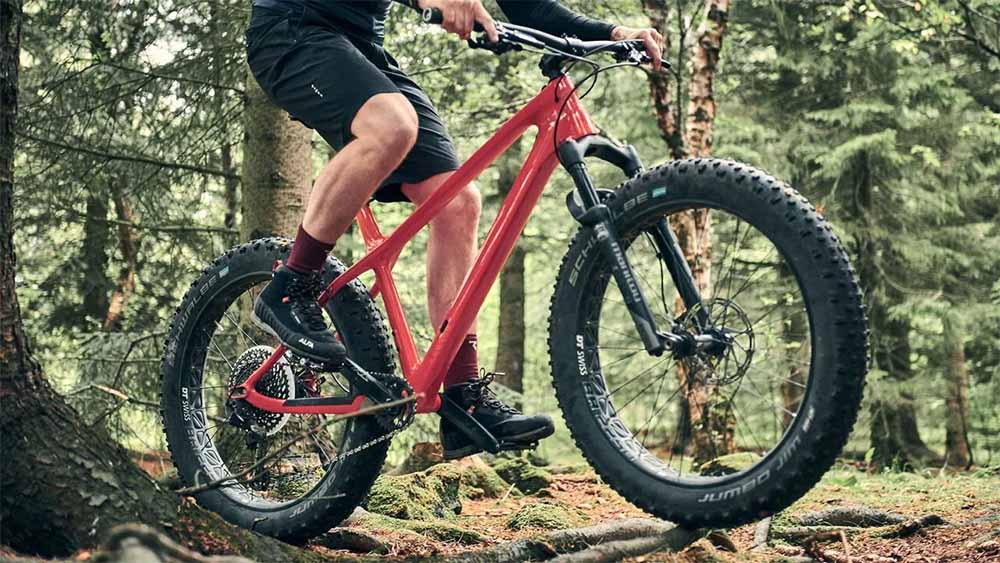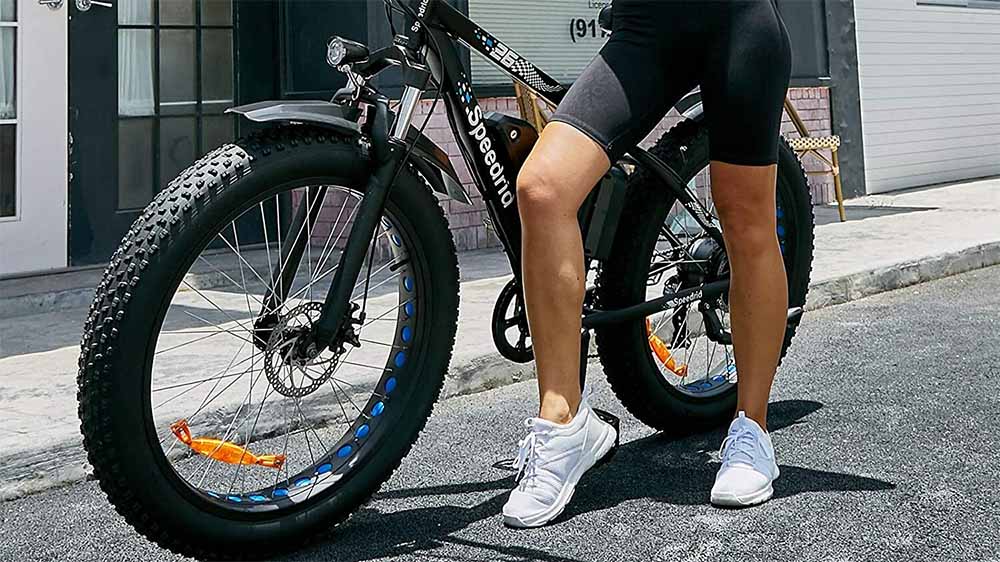Can I put fat tires on mountain bike?

Spring is here and it’s time to get my mountain bike ready for the long summer trail rides and morning commutes. The only problem is that I need to put fat tires on mountain bike before it’s ready to travel around the block. So, I was wondering if I could fit wider tires on my mountain bike to make it more like the fat mountain bike I’ve been riding all winter.
Fitting wider tires on mountain bikes
While you may never be able to convert a normal mountain bike into a full-fledged fat-tire mountain bike, you can increase the width of the tires to some extent. The two main constraints are the width of the rim and the clearance of the fork, keeping these in mind, the width can be increased.
How Mountain Bike Tire Sizing Works
First, the most basic information you need to know is mountain bike tires
There are three standard diameters. These diameters are…
26 inches
27.5 inches
29 inches
No matter what width your tires are, this is the first thing to consider when looking for new tires for your mountain bike. The inner diameter of the tire has to match the rim of the mountain bike, or you’ll be completely useless because it won’t fit the bike at all.
Mountain Bike Pre-ride Checklist
Most US mountain bike tire manufacturers will use this notation to indicate size, although it is important to know that while the decimal form of the notation equals their fractional counterparts are mathematically equivalent, in practice they will be different size. It is always better to compare measurements found in the same format.
Mountain Bike Tires Wheels and Tire Widths
The second way to measure mountain bike tires is by width. For regular mountain bikes, widths vary from 1.6 inches to 2.5 inches. Although, some models will even go as high as 3 inches, but that’s not the standard. Generally, thinner rim mountain bikes will accommodate the width around the lower end, while thicker rim mountain bikes will certainly fit thicker mountain bikes.
Over the years I have had the opportunity to do real life “tests” on many different tires. In turn share what I’ve learned and describe the characteristics of the quality tires I’ve compiled for this list.
The Best Mountain Bike Tires for Streets and Trails – It’s Really Hard to Do. Balancing the durability and traction of a mountain bike tire can be difficult.
Best Mountain Bike Tires for Rocky Terrain – Rock Eats Mountain Bike Tires. Aggressive tread with high puncture resistance.
Best Mountain Bike Tires for MUDs – My local singletrack trails are sloppy after every rain. It is critical to shed mud and maintain a grip.
A good way to accurately size your mountain bike’s tires according to the manufacturer’s standards is to look at the number on the side of the tire that came with your bike. The numbers are easy to understand with a little explanation. An example of what such a size representation might look like is… 27.5 x 2 Maybe 27.5 x 1 5/8 x 2
In the first example, the first number (27.5) represents the diameter of the tire and the second number represents the width of the tire. In the second example, an optional representation of the tire’s height off the rim has been placed between diameter and width. It’s less common, but you may encounter it, so it’s still important to keep in mind.
However, these imperial markings are not always exactly equal to the rim diameter and width, although the tire may appear to “fit” the rim and is actually the correct size in most cases. It is for this reason that the International Organization for Standardization (ISO) (some old mountain bike tires may have previously been referred to in the European Tire and Rim Technology Organization (ETRTO)) created a standard system for measuring marks. These marks will be in standard size
559 mm
584 mm
622 mm
These numbers match the common imperial sizes, although more standard among domestic and foreign manufacturers, and actually indicate the exact inner diameter rather than the outer diameter of a mountain bike tire. Also, in the ISO sizing system, the width of the tire is actually shown before the number representing the diameter. This number will be between 13mm and 40mm, again matching the imperial 1.6 to 2.5 inch mark. Although it does not represent the width of the tire, but the internal width of the rim itself.

How to choose the right tires for your mountain bike
Putting all these things together allows you to choose the right tire. If you want to keep the same tire size as the one that came with your bike, it’s easy. Just match the markings on the side of your bike’s tires to the new tires you plan to buy (I’ll explain more later, given the style of tires you’re buying). However, if you want to change the width, the process is different.
The two measurements that must match the specified size recommended by the manufacturer are the first and second ISO marks. This won’t change much, as if the tires don’t fit properly on the bike rim. However, the numbers that can be changed are imperial measurements of tire width. A sort of
Again, two things must be considered when deciding how to change the width. The first is whether the width of the tire will fit the width between the forks and if it will interfere with the chainstays of the chainstays. There is no way to know if the tires will fit other than measuring these distances yourself, there are no standard sizes for these.
The second is whether the ratio of the inner width to the outer width of the tire is safe and will not cause any strange handling problems. Here is a chart showing which ratios are safe and which are not.
x stands for those safe configurations. Also, compared to imperial notation, outside diameter measurements can be approximated to their nearest imperial equivalent.
How to measure fork chain assemblies for proper clearance
When trying to fit wider tires to a mountain bike, measuring everything correctly beforehand can prevent nasty surprises when fitting new tires to your mountain bike. At the front, you have to measure the space between the fork struts to accommodate the width and height of the first part of the suspension from the rim to where the tires may touch, to accommodate the height of the new tires.
In the back Depending on how your bike’s frame looks, you may need to measure the width between the frame sections. In any case, you must measure the width of the new tire if it will be in contact with the chain or chain assembly of the mountain bike in any way. For obvious reasons, this is not good.
What are the pros and cons of using wider tires
Today, many riders prefer wider tires. The simple reason for this is that thicker tires allow you to ride at lower psi, followed by thinner, smaller volume tires. There are three main advantages to having low psi and thick tires…
Comfort: Riding with high volume tires at low psi is like a suspension system where a lot of the shock is actually absorbed by the tire itself. This is useful when riding on not exactly firm ground or particularly rough trails.
Ride with ease: Thicker tires result in a more balanced experience. This makes it easier to control the bike at high speeds and when tackling uneven terrain. Wider tires provide a wider pivot point, making it harder to lean the bike.
Versatile: Bikes with wider tires are great for trails and rough terrain, but they can also excel on smooth roads or trails. With thicker, wider tires, you’re not as restricted to one terrain as with thinner tires.
Although, thick tires have some drawbacks; all of which come down to the issue of increased friction. By definition, thicker tires mean you’ll have more rubber touching the ground, which may mean it won’t be as easy to move around if you’re on the road a lot. Especially if you commute on a mountain bike.

Types of Mountain Bike Tires
Slick mountain bike tires: These tires are designed for road use and have virtually no tread. They do have a track that spans the circumference of the tire, which creates a V-shape that helps with cornering.
Semi-slick mountain bike tires: These tires are designed with a smooth center and knobby sides. These offer maximum acceleration and roll speed, but still provide excellent cornering.
Knobby mountain bike tires: These tires have multiple levels of aggression in the tread. This is most commonly used by mountain bikes as they provide the best traction in all conditions.
Upside-down mountain bike tires: These have indentations and look exactly like what you might think based on the name. Instead of protruding knobs, they have dents that go into the tires. These are typically used on bikes that are primarily intended for road use but may occasionally be off-road.
How to install wider mountain bike tires:
Choose the correct size for whatever style of tire you plan to replace your old tire with. Remember to buy imperial size specific tires if you are changing the width of the other two sizes I mentioned.
Turn the bike upside down and remove the axle to disengage the wheel from the frame of the mountain bike.
Remove the old tire by positioning the valve stem and using the beveled end of the tire iron on the opposite side of the rim to separate the wheel from the rim. Continue doing this every inch until the old tire is completely removed.
If your tires have tubes, wash them with water. It’s a good idea to inflate the tube to try and find any holes or tears. (only do this if you plan to reuse the tube)
Otherwise, put new tires on the rim. This should be easy since it’s not inflated yet.
Put the wheel back on the bike and reinsert the axle into the mountain bike to reconnect the wheel to the frame.
Pump the tire back to the manufacturer’s standard, or if you’re an experienced rider, run the tire at any psi you like.
If you are looking for a new way of commuting or want a healthier lifestyle, we are here to help you. Visit our website to learn more about electric bikes and electric scooter or please leave information to us.
 Shuangye ebike
Shuangye ebike
